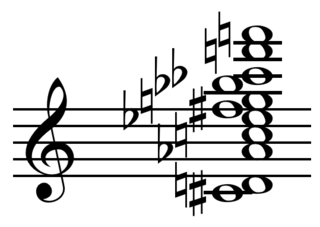Related Research Articles

A harmonic is a wave with a frequency that is a positive integer multiple of the fundamental frequency, the frequency of the original periodic signal, such as a sinusoidal wave. The original signal is also called the 1st harmonic, the other harmonics are known as higher harmonics. As all harmonics are periodic at the fundamental frequency, the sum of harmonics is also periodic at that frequency. The set of harmonics forms a harmonic series.

An overtone is any harmonic with frequency greater than the fundamental frequency of a sound. In other words, overtones are all pitches higher than the lowest pitch within an individual sound; the fundamental is the lowest pitch. While the fundamental is usually heard most prominently, overtones are actually present in any pitch except a true sine wave. The relative volume or amplitude of various overtone partials is one of the key identifying features of timbre, or the individual characteristic of a sound.

Overtone singing – also known as overtone chanting, harmonic singing, polyphonic overtone singing, and diphonic singing – is a set of singing techniques in which the vocalist manipulates the resonances of the vocal tract, in order to arouse the perception of additional, separate notes beyond the fundamental frequency being produced.

Ethnomusicology is the study of music from the cultural and social aspects of the people who make it. It encompasses distinct theoretical and methodical approaches that emphasize cultural, social, material, cognitive, biological, and other dimensions or contexts of musical behavior, in addition to the sound component.

A shakuhachi is a Japanese and ancient Chinese longitudinal, end-blown flute that is made of bamboo.
Ear training or aural skills is a music theory study in which musicians learn to identify pitches, intervals, melody, chords, rhythms, solfeges, and other basic elements of music, solely by hearing. The application of this skill is analogous to taking dictation in written/spoken language. As a process, ear training is in essence the inverse of sight-reading, the latter being analogous to reading a written text aloud without prior opportunity to review the material. Ear training is typically a component of formal musical training and is a fundamental, essential skill required in music schools.
The igil is a two-stringed Tuvan musical instrument, played by bowing the strings. The neck and lute-shaped sound box are usually made of a solid piece of pine or larch. The top of the sound box may be covered with skin or a thin wooden plate. The strings, and those of the bow, are traditionally made of hair from a horse's tail, but may also be made of nylon. Like the morin khuur of Mongolia, the igil typically features a carved horse's head at the top of the neck above the tuning pegs, and both instruments are known as the horsehead fiddle.
Paul Jerrod Pena was an American singer, songwriter and guitarist of Cape Verdean descent.
Tuva is a part of Russia, inhabited by a Turkic people. Tuvans are known abroad for khoomei (xöömej), a kind of overtone singing.

Sainkho Namtchylak is a singer originally from Tuva, an autonomous republic in the Russian Federation just north of Mongolia. She is known for her Tuvan throat singing or Khöömei.

In musical composition, a sound mass(also sound collective, sound complex, tone shower, sound crowd, or cloud) is the result of compositional techniques, in which, "the importance of individual pitches", is minimized, "in preference for texture, timbre, and dynamics as primary shapers of gesture and impact", obscuring, "the boundary between sound and noise".

Spectral music uses the acoustic properties of sound – or sound spectra – as a basis for composition.
Frank Denyer is a composer. His music uses a combination of conventional instruments and new, unusual, and structurally modified instruments. Partly due to his studies of non-Western music, much of Denyer's music is microtonal.
Timbre composition is the art of creating new timbres. It is often performed electronically, either by combining sine waves or by filtering out harmonics from more complex waves.
Throat singing refers to several vocal practices found in different cultures around the world. The most distinctive feature of such vocal practices is to be associated to some type of guttural voice, that contrasts with the most common types of voices employed in singing, which are usually represented by chest (modal) and head registers. Also, throat singing is often described as producing the sensation of more than one pitch at a time, i.e., the listener perceives two or more distinct musical notes, while the singer is producing a single vocalization.

Tuvan throat singing, the main technique of which is known as khoomei, includes a type of overtone singing practiced by people in Tuva, Mongolia, and Siberia. In 2009, it was included in the Representative List of the Intangible Cultural Heritage of Humanity of UNESCO. The term hömey / kömey means throat and larynx in different Turkic languages. That could be borrowed from Mongolian khooloi, which means throat as well, driven from Proto-Mongolian word *koɣul-aj.
Valentina Suzukei is one of the leading ethnomusicologists in the Tyva Republic (Tuva), Russia.
Theodore Craig Levin is an American ethnomusicologist. He is a professor of music at Dartmouth College in New Hampshire and earned his undergraduate degree at Amherst College and obtained his Ph.D. from Princeton University. Levin has focused his research on the people of the Balkans, Siberia, and Central Asia. His recordings from these regions have been released on various labels.

Shamanic music is ritualistic music used in religious and spiritual ceremonies associated with practice of shamanism. Shamanic music makes use of various means of producing music, with emphasis on voice and rhythm.

Aldyn-ool Takashovich Sevek was a master Tuvan throat singer.
References
- ↑ Süzükei, V., Listening The Tuvan Way in Levin, T., Where Rivers and Mountains Sing, Sound, Music and Nomadism in Tuva and Beyond (Bloomington: Indiana University press, 2006) p. 47.
- ↑ Waters, S., "Timbre Composition: Ideology, Metaphor and Social Process", Contemporary Music Review, 10:2 (1994), p133-134
- ↑ Levin, T., Where Rivers and Mountains Sing, Sound, Music and Nomadism in Tuva and Beyond (Bloomington: Indiana University press, 2006) p58
- ↑ Süzükei, V., Listening The Tuvan Way in Levin, T., Where Rivers and Mountains Sing, Sound, Music and Nomadism in Tuva and Beyond (Bloomington: Indiana University press, 2006) p51.
- ↑ Landy, L., 'The Something to Hold on to Factor in Timbral Composition', "Contemporary Music Review" 10:2 (1994): 54.
- ↑ Fales, C., "The Paradox of Timbre", Ethnomusicology, 46:1 (Winter, 2002), 57.
- ↑ Waters, S., "Timbre Composition: Ideology, Metaphor and Social Process", Contemporary Music Review, 10:2 (1994), p131, 134
- ↑ Fales, C., "The Paradox of Timbre", Ethnomusicology, 46:1 (Winter, 2002), 56
- ↑ Helmuth, M., "Timbral Composition and Gesture" Columbia University Music Department, available at "Timbral Composition and Gesture". Archived from the original on 2002-01-21. Retrieved 2008-10-29.
- ↑ Berger, Donald Paul (Autumn, 1969). "The Shakuhachi and the Kinko Ryu Notation". Asian Music 1 (2): 32–72. Springer. doi : 10.2307/833910.
- ↑ Quesnel, R., "Timbral Ear Trainer: Adaptive, Interactive Training of Listening Skills for Evaluation of Timbre Differences", paper presented at the 100th Audio Engineering Society Convention, Copenhagen, May 11th–14th, 1996.